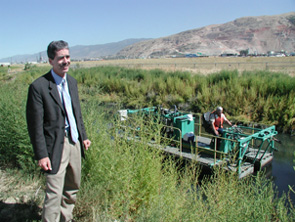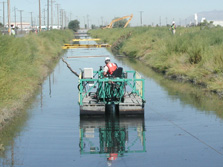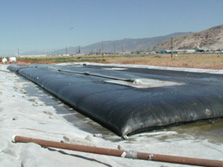Northwest Oil Drain – Sewage Canal Cleanup Project
Removing 41,000 cubic yards of contaminated sediments allows maintenance of critical waterway in Salt Lake County, Utah.
August 31, 2004
|
In 1999 EPA became concerned that there may be environmental impairment resulting from hydrocarbon contaminated sediments in the Canal System. From 1921 to the late 1950s several refineries and a railroad maintenance facility had discharged byproducts into the Canal System. EPA notified the City and County that the federal agency was going to conduct an assessment of the canal to determine if it should be placed on the national priority Superfund list for cleanup, which could take years of study and many more to take action.
In the mean time necessary maintenance on the canal was stalled because of the potential problems associated with the contaminated sediments. The canal sediments needed to be removed to restore hydraulic conveyance capacity; however, both the City and County were concerned about the environmental liability of removing them.
The cleaning project culminated nearly 5 years of engineering, scientific study and negotiations with various entities to determine the best method of removing the sediments and allocating the cost between the various parties. The time taken to develop a solution and work plan to address the environmental concerns were described as “necessary and beneficial” according to City public utilities deputy director Jeff Niermeyer. He noted, “It was well worth the time as it resolved a potentially serious environmental problem in a timely manner with significant cost savings to all involved.”
Early estimates of the cost of the Northwest Oil Drain cleanup were estimated at over $100 million using the typical EPA approach to remedial action for Superfund sites. The City and County made the decision early to be proactive in the process of assessing the Canal System for environmental impairment and implementing a cleanup plan.
The first step to solving the cleanup problem was to involve all of the stakeholders. The Northwest Oil Drain Working Group (Working Group) was formed by the City, County, BP Amoco and Chevron as a cooperative effort to collect data and study alternatives for removal of the contaminated sediments. The City also retained the services of an experienced environmental attorney. The City’s Jeff Niermeyer chaired the Working Group. Also added to the stakeholder group were the U.S. Fish & Wildlife Service, State Division of Environmental Quality, Division of Water Quality and the Salt Lake Valley Health Department.
|
The Work Group undertook the study with the goal of fully addressing the environmental concerns of the contaminated sediments at the lowest possible cost to the stakeholders. The ultimate remedy was based on good science and an understanding of the legal and statutory authority governing the issues. All of the stakeholders agreed on the cleanup remedy, which was presented to the EPA for approval.
On August 28, 2003 the Work Group entered into an agreement for cost allocations and settlement regarding the Northwest Oil Drain segment cleanup. EPA Region VIII issued an “Administrative Order On Consent For Removal Action” on November 24, 2003.
On April 19, 2004 the City entered into a contract with Compass Environmental, Inc. (A Chicago, Illinois based company) in the amount of $2,795,716 for the cleanup of the “Up-Stream” segment of the canal. Over 41,000 cubic yards of contaminated sediments are being removed by the use of a cable controlled hydraulic dredge equipped with an auger and pumping system that removes the contaminated sediments from the canal. The material is then conveyed to a large bladder (Geotube®) for dewatering and disposal. The County is removing sediments using standard dredging methods from the “Down-Stream” segment of the Canal System that is not contaminated.
The final total project remedy cost is estimated at just under $5,000,000, a mere five percent of the initial cost estimate. The process was summed up by Niermeyer, “In this case taking a proactive approach to environmental problems paid off in the long-run, with quicker action and lower costs.”
The cleanup is scheduled to be completed by early 2005.


